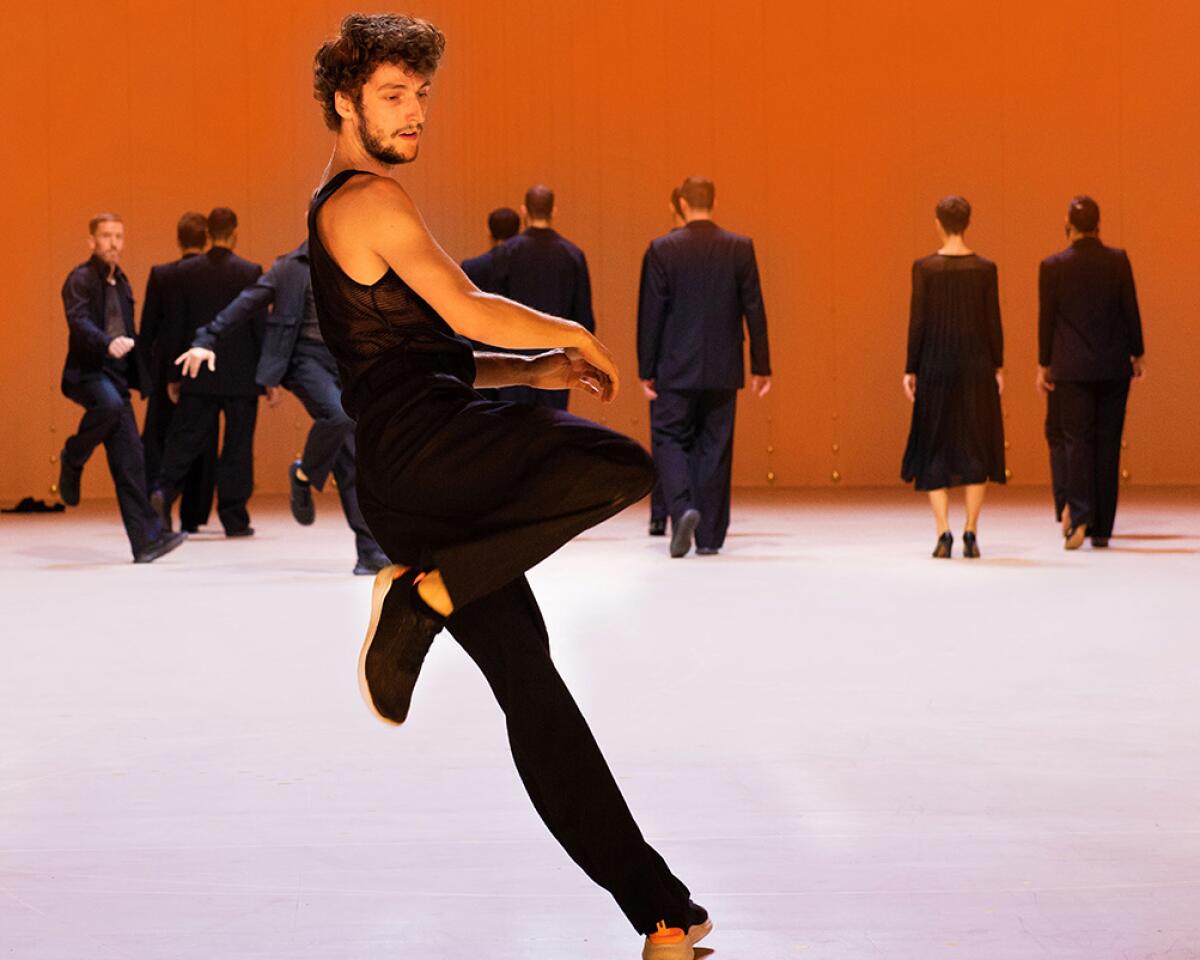Commentary: It’s been a year to rethink Bach’s ‘Brandenburg’ Concertos

No one needs to be told why “The Messiah” or “The Nutcracker” have become Christmas perennials. There are, of course, further Christmas-themed works of glory galore. It’s time we dig out Bach’s joyous “Christmas” Oratorio, Berlioz’s ravishing “L’Enfance du Christ,” Liszt’s cinematic “Christus,” Honegger’s contemplative “Christmas” Cantata, Christopher Rouse’s carousing “Karolju” and George Crumb’s adorable “Little Suite for Christmas,” for starters.
As for New Year’s, the Strausses long ago provided the waltzes. In Japan, one auld acquaintance not to be forgotten is Beethoven’s Ninth Symphony. It is given ritual year-end performances throughout the country as a reminder of its message of universal union between peoples and the cosmos, increasingly a lodestar for our divided and environmentally devastated world.
But who put Bach’s “Brandenburg” Concertos in the holiday mix? These six Baroque chamber concertos for diverse instruments have happily wandered into the seasonal concert circuit (they are a favorite Los Angeles Chamber Orchestra December treat in non-pandemic years, and the Chamber Music Society of Lincoln Center recently brought them to Costa Mesa). The concertos don’t have anything to do with anything, other than being a demonstration of Bach’s amazing ingenuity and his inordinate ability to delight.
The fact that the concertos stand apart from all other holiday music favorites, however, allows them to resist ready commercialization, and they are the gift that keeps on giving.
This year celebrates the 300th anniversary of Bach having presented the concertos as a gift to the Margrave Christian Ludwig of Brandenburg on March 24, 1721. The composer’s stated intention was to give His Royal Highness pleasure (not that Bach didn’t imply that a little employment wouldn’t hurt). Musicologists are not so sure about the margrave’s penchant for pleasure (Bach didn’t get the job), but the concertos have continued to cheer music lovers for three centuries.
During this “Brandenburg” birthday year, a slew of new recordings of the concertos, presented every which way, have been released. This includes new versions played in various attempts at historic authenticity, reissued historic recordings by great performers of yore who didn’t give a hoot about how we might presume Bach did it, re-creations of the concertos for modern tastes and cheeky new works written in provocative response to the concertos. There is also a recent release on DVD and Blu-ray of choreographer Anne Teresa De Keersmaeker’s thrilling “The Six Brandenburg Concertos” for her extraordinary Belgian dance company, Rosas.
Renditions of the concertos come clothed in recordings called “Bach Unbuttoned” (a lively flute-centric account of the six concertos featuring Ana de la Vega), “The Hidden Reunion” (the sixth concerto recorded in Amsterdam lockdown), “(re)creations” (which includes a solo piano version of a “Brandenburg” movement played by Zlata Chochieva) and “The Dream Net” (saxophonist Masato Kumoi having her “Brandenburg” way). The reissues include Bach in grand Soviet style from violinist David Oistrakh and pianist Emil Gilels, as well as a movingly romanticized performance of the “Brandenburg Fifth” by Harold Samuel (one of the first pianists to record Bach) from 1935 and a grippingly modern-sounding performance of that concerto at cellist Pablo Casals’ 1950 Prades Festival; it includes the fluid American pianist Eugene Istomin and the sizzling violinist Joseph Szigeti. There also have been the inevitable new additions to recordings on old instruments, itself something of old news.
But one set turns out to be the knockout of the “Brandenburg” year. In 1997, the Akademie für Alte Musik Berlin made a dutiful recording of the concertos, careful not to violate norms of what we now call historically informed performance (or HIP). Over nearly a quarter-century of “Brandenburg”-ing, the period instrument Berliners have loosened up and, during lockdown, made a buoyant new recording. It features violinist Isabelle Faust and violist Antoine Tamestit, two especially dynamic soloists who bring with them exceptional contemporary music chops.
That is not to say these performances, which are spectacularly recorded (especially if played as high-resolution downloads or streams) aren’t HIP. They bring out the pizzazz that was always, for Bach, the point of his “Brandenburgs.”
Indeed, what is special about the “Brandenburgs,” and so much so for this time of year, is that Bach uses virtuosity both to express a life-giving enthusiasm and to suggest a model for democracy. The democratic idea comes from the diversity. Every concerto is different in its use of soloists. Bach, for example, dramatically breaks down traditional instrumental hierarchies when he gives prominence to the usually buried viola section in the third concerto. He makes the faint harpsichord that typically serves to underscore other instruments a flashy protagonist in the fifth. With fast, exciting tempos and simply incredible playing, the Akademie’s new recording puts a spectacular emphasis on the extremes of instrumental color that, with its vivid miking, take on a visceral sense of purpose, a downright thrilling call to democracy in action.
Musings on what has emerged in 2021 and what hasn’t.
If the Akademie makes the concertos newly fresh and relevant, the Swedish Chamber Orchestra goes a step further and makes them completely new with what it calls “The Brandenburg Project.” Over a period of several years, the orchestra commissioned six internationally prominent composers to come up with companion pieces to each of the concertos; they were first performed as a whole at the Proms in London in 2018 and now have been recorded. Each composer was required to respond to the given concerto with similar soloists, although one solo could be changed. Each also chose to write for a noted soloist, who may or may not participate in the Bach concerto performance as well. Some followed Bach’s structures. Some quoted Bach; many intentionally misquoted Bach. Some messed with the actual concerto performance. They all blithely bent rules when they wanted.
Mark-Anthony Turnage went his own way in “Maya” for the first concerto, cutting out Bach’s startling hunting horns and adding a soulful cello part written for Maya Beiser. Steven Mackey, whose new trumpet concerto, “Shivaree,” was a highlight of the Los Angeles Philharmonic’s fall concerts, provided here an earlier jazzy trumpet concerto, this one called “Riceros,” for Hakan Hardenberg to go along with Bach’s piccolo-trumpet-dominated second Brandenberg. Anders Hillborg’s rendition added a second movement to the third Brandenburg and then continued with a Bach-infused and folk-infused follow-up, “Bach Materia,” which includes two fantastical improvisations by violinist Pekka Kuusisto.
Kuusisto is also the soloist in the fourth Brandenburg, but Olga Neuwirth replaces him with flutist Claire Chase in “Aello.” In what Neuwirth dubbed a “Ballet mécanomorphe,” she takes themes from the concerto and puts them in a delirious Bach mashup that includes a synthesizer, a clattering Olivetti Lettera 22 typewriter filling in for the harpsichord and various other instruments tuned to different frequencies as they march to their own harmonic steps in a bizarrely mechanized dance. Jazz pianist Uri Caine wrote his own three-movement concerto for his own unpredictable self in “Hamsa” that follows the fifth Brandenburg. Brett Dean’s “Approach — Prelude to a Canon” features two violists (Tabea Zimmermann and Dean himself) played before the last “Brandenburg,” creating its own mysterious mood. Thomas Dausgaard conducts all with flair.
You can’t possibly have heard the “Brandenburgs” like this before. And with De Keersmaeker’s dance for her company Rosas, you certainly haven’t seen them like this before.
Using the spunky, Ghent, Belgium-based period instrument ensemble B’Rock Orchestra, led by violinist Amandine Beyer in the pit, the stylish dancers walk onstage with seductive yet challenging attitude, a teasing flip of the foot to an occasional downbeat the initial movement of the first concerto. After 90 movement-searching and soul-searching minutes, they’ve become characters in a non-narrative drama, become the musical instruments themselves and most of all reached a hard-earned state of jubilant liberation.
Music and movement do not necessarily go hand in hand (or hand in foot) for De Keersmaeker, who has been at her most amazing choreographing to Steve Reich and Gérard Grisey. Her dancers’ rhythms never replicate what is on the page of the score. Instead, rhythm and melody and counterpoint and texture act as stimuli to movement. They are the switch that turns on the dance. While the dance can be streamed on Vimeo, the sound and picture are best on Blu-ray.
Now that it’s Bach season once again, here are a handful of the year’s otherwise best Bach bets. In “Bach: The Art of Life,” Daniil Trifonov probes the art of spiritually multidimensional counterpoint in Bach’s “The Art of the Fugue.” On his latest recording, organist Cameron Carpenter re-creates the Technicolor wizardry he brought to Bach’s “Goldberg Variations” at Walt Disney Concert Hall in October.
Cedille Records has collected, in a four-box CD set, Jennifer Koh’s mesmerizing “Bach and Beyond,” her multiyear commissioning project for new solo violin pieces to accompany Bach’s solo violin Sonata and Partitas. For the fun of it, countertenor Andreas Scholl and guitarist Edin Karamazov contrast Bach with the contemporary Cuban composer Leo Brouwer.
Bach, it probably goes without saying, goes with anything. And the final proof is in one of the year’s most amazing recordings, “Lucier & Bach: Sitting in a Room.” In response to the lockdown, German soprano Hanna Herfurtner intercuts arias from Bach cantatas with Alvin Lucier’s composition for a reader whose voice is rerecorded over and over in performance, distorting the sound of the voice to the point where it becomes an electronic reflection of the room’s inherent acoustical resonances. Herfurtner treats this as an emotional journey, like the one we’ve all, each in our own way, taken over the last two years of enforced isolation, the darkness and the presumed light at the end of the tunnel.
More to Read
The biggest entertainment stories
Get our big stories about Hollywood, film, television, music, arts, culture and more right in your inbox as soon as they publish.
You may occasionally receive promotional content from the Los Angeles Times.












